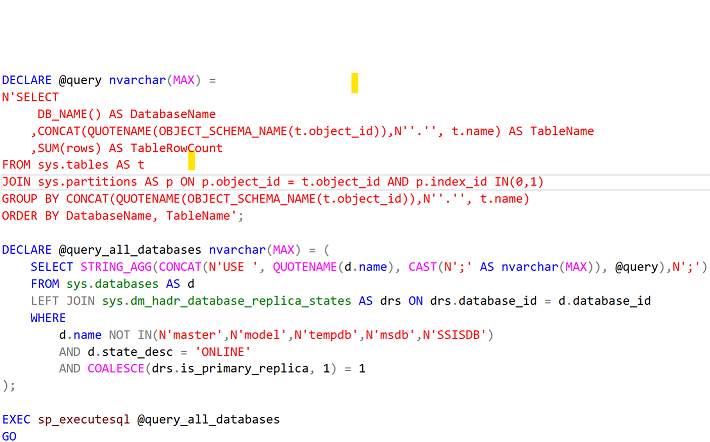Hi @mo boy ,
Approach 1: sys.partitions Catalog View
sys.partitions is an Object Catalog View and contains one row for each partition of each of the tables and most types of indexes (Except Fulltext, Spatial, and XML indexes). Every table in SQL Server contains at least one partition (default partition) even if the table is not explicitly partitioned.
The T-SQL query below uses the sys.partitions catalog view to capture the row counts for all tables in a database.
SELECT
QUOTENAME(SCHEMA_NAME(sOBJ.schema_id)) + '.' + QUOTENAME(sOBJ.name) AS [TableName]
, SUM(sPTN.Rows) AS [RowCount]
FROM
sys.objects AS sOBJ
INNER JOIN sys.partitions AS sPTN
ON sOBJ.object_id = sPTN.object_id
WHERE
sOBJ.type = 'U'
AND sOBJ.is_ms_shipped = 0x0
AND index_id < 2 -- 0:Heap, 1:Clustered
GROUP BY
sOBJ.schema_id
, sOBJ.name
ORDER BY [TableName]
GO
Below are the highlights of this approach:
- Requires membership in the public role.
- Can be used even when working with source systems which offer limited privileges such as read-only.
Approach 2: sys.dm_db_partition_stats Dynamic Management View (DMV)
sys.dm_db_partition_stats is a Dynamic Management View (DMV) which contains one row per partition and displays the information about the space used to store and manage different data allocation unit types - IN_ROW_DATA, LOB_DATA and ROW_OVERFLOW_DATA.
The T-SQL query below uses the sys.dm_db_partition_stats DMV to capture the row counts for all tables in a database.
SELECT
QUOTENAME(SCHEMA_NAME(sOBJ.schema_id)) + '.' + QUOTENAME(sOBJ.name) AS [TableName]
, SUM(sdmvPTNS.row_count) AS [RowCount]
FROM
sys.objects AS sOBJ
INNER JOIN sys.dm_db_partition_stats AS sdmvPTNS
ON sOBJ.object_id = sdmvPTNS.object_id
WHERE
sOBJ.type = 'U'
AND sOBJ.is_ms_shipped = 0x0
AND sdmvPTNS.index_id < 2
GROUP BY
sOBJ.schema_id
, sOBJ.name
ORDER BY [TableName]
GO
Below are the highlights of this approach:
- VIEW DATABASE STATE permissions are required in the database.
- The values in the sys.dm_db_partition_stats DMV are reset on server restart or when an object/partition is dropped and recreated.
In general, querying the Dynamic Management Views (DMVs), requires VIEW SERVER STATE or VIEW DATABASE STATE permissions based on the Dynamic Management View/Function which is being queried.
Best regards
Niko
----------
If the answer is the right solution, please click "Accept Answer" and kindly upvote it. If you have extra questions about this answer, please click "Comment".


